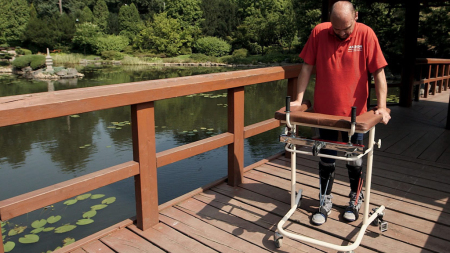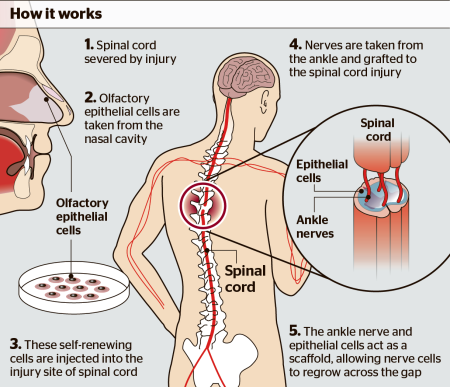A paraplegic man has, it is claimed, had his severed spinal cord ‘repaired’, but what are the facts behind the sensational headlines
In pioneering research, transplanted cells have been used to stimulate the repair of a man’s spinal cord. The headlines are based on a scientific report describing a 38-year-old man whose spinal cord was almost completely severed in a knife attack. The man had completely lost feeling and movement below the injury and was paralysed from the chest down.

Researchers injected the man’s damaged spinal cord with cells taken from parts of the brain involved in interpreting smell signals from the nose to the brain. This treatment was combined with a graft from one of the nerves in his lower leg to reconnect the stumps of spinal cord severed by the injury.
After surgery, the man had improved trunk stability, partial recovery of the voluntary movements of the lower extremities, and an increase of muscle in one thigh, as well as improvements in sensation. According to an accompanying press release, the man is now able to walk using a frame.
While previous techniques have managed to “re-route” nerve signals around a damaged section of the spinal cord, this is the first time that damage to the cord has been directly repaired.
These results are very encouraging, but, as the researchers note, the findings will need to be confirmed in other patients with similar types of spinal cord injury.
Where did the story come from?
The study was carried out by researchers from Wroclaw Medical University, the Polish Academy of Sciences, Karol Marcinkowski Medical University, the Neurorehabilitation Center for Treatment of Spinal Cord Injuries AKSON in Poland, the Medical University of Warsaw, the University Clinical Hospital and the UCL Institute of Neurology in the UK.
It was funded by the Wroclaw Medical University, the Nicholls Spinal Injury Foundation and the UK Stem Cell Foundation.
The study was published in the peer-reviewed journal Cell Transplantation and has been made available on an open access basis, so it is free to read online.
The news was widely reported by both the UK and international media. Coverage was accurate, if uncritical. The lead author’s claim that this research was “more impressive than man walking on the moon” seems to have been accepted without question by the media.
However, other experts are less impressed. For example, Dr Simone Di Giovanni, Chair in Restorative Neuroscience at Imperial College London, is reported by the Science Media Centre as saying, “One case of a patient improving neurological impairment after spinal cord knife injury following nerve and olfactory cell transplantation is simply anecdotal.
“Extreme caution should be used when communicating these findings to the public, in order not to elicit false expectations on people who already suffer because of their highly invalidating medical condition.”
What kind of research was this?
This was a case report, which often report unusual medical findings in a single person. They often describe rare diseases, strange symptoms or untypical responses to treatment.
The results of this case report will need to be confirmed in a larger group of patients with similar types of spinal cord injury before such stem cell transplants can be said to be an effective treatment for spinal cord injuries.
Even if the treatment proves effective, it may not be safe in all cases. Because of its complexity, neurological surgery has a higher rate of complications than most other types of surgery.
What did the research involve?
The case report describes a 38-year-old man whose spinal cord was damaged in a knife attack, leading to his spinal cord being almost completely severed. The man had completely lost sensory (feeling) and motor (movement) function below the injury, resulting in paraplegic paralysis (where both legs and the lower body are paralysed).
The researchers removed one of his olfactory bulbs, the parts of the nervous system that normally transmit information on smell from the nose to the brain. They then grew cells from the man’s olfactory bulbs in the laboratory. They were interested in two cell types: olfactory ensheathing cells and olfactory nerve fibroblasts. Both of these cell types have been shown to mediate regeneration and the reconnection of severed axons (nerve cells).
The researchers transplanted the cultured cells by injection into the man’s spine above and below the injury. To fully bridge the gap and reconnect the stumps of spinal cord severed by the injury, they also combined this treatment with a graft of small strips of nerve taken from one of the nerves in the man’s lower leg (the sural nerve).
The man received intense neurorehabilitation through exercises and other interventions designed to help recovery from a nervous system injury or compensate for its effects.
What were the basic results?
The man seemed to have no adverse effects in the 19 months following the operation. From five months after the operation, the man had improved neurological function. By 19 months after surgery, he had improved trunk stability (sometimes known as core stability), partial recovery of the voluntary movements of the lower extremities, and an increase in the muscle of one thigh, as well as improvements in sensation (feeling). According to accompanying media reports, the man is now able to walk using a walking frame.
Interestingly, removal of one of the olfactory bulbs did not cause the man to permanently lose his sense of smell on one side, as might have been expected.
How did the researchers interpret the results?
The researchers conclude that to their knowledge, “This is the first clinical indication of beneficial effects of transplanted autologous bulbar cells.”
Conclusion
Overall, these results demonstrate the first person with a severed spinal cord to have regained movement and sensation in his lower limbs following a cell transplant. Specifically, this involved a combination of cells taken from the olfactory bulb and a graft from nerve cells in the leg, which were used to reconnect the severed sections of spinal cord. These results are very encouraging, but, as the researchers note, these will need to be confirmed in a larger group of patients with similar types of spinal cord injury.
Further research is also required into how best to access the olfactory bulb. In this study, it was accessed by craniotomy – a surgical operation where a bone flap is temporarily removed from the skull to access the brain. As the researchers also state, there remains a possibility that sources of other, more readily obtainable reparative cells may be discovered.
Though this treatment has given good recovery of movement and sensation, there has not yet been a full recovery in terms of bowel, bladder and sexual function. These functional effects of spinal cord injury can of course have an equally devastating effect on a person as loss of movement or sensation.
The results will undoubtedly give hope to many people affected by paralysis as a result of spinal cord injury. However, while very promising, there are still many steps to go until a new treatment is found that gives complete functional recovery from severe spinal cord injury. Source: NHS











